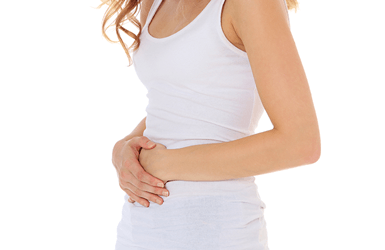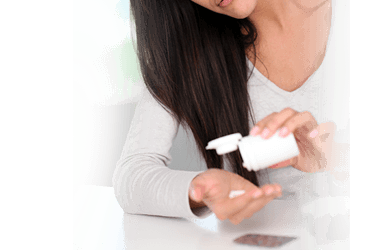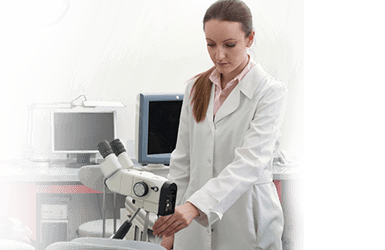Pelvic Pain
Period Pain
Period pain or dysmenorrhea is a condition of painful menstrual periods. Menstrual cramps or pain is felt in the abdominal areas and can occur before the menstrual cycle begins and can continue for 2 to 3 days.
Primary dysmenorrhea is the common painful condition in women with no abnormalities in pelvic region. Women may experience severe pain before or at the onset of menstrual periods and the pain persists for 2–3 days. Primary dysmenorrhea is caused by the elevated levels of hormone prostaglandin produced by the tissues lining the uterus (womb). Prostaglandin triggers the uterine muscles to contract and push the uterus lining (endometrium) out of the body through vagina. Women who have high level of prostaglandin will experience intense pain and contractions.
Secondary dysmenorrhea is the painful condition that may be caused because of other gynaecological problems. This kind of pain begins early in menstrual cycle and lasts longer than primary dysmenorrhea. Conditions that may cause secondary dysmenorrhea includes endometriosis, fibroids, infection, ovarian cysts, narrow cervix, abnormal pregnancy, and intrauterine device for birth control.
Some of the commonly observed symptoms are back pain, leg pain, nausea, vomiting, diarrhoea, headache, irritability, weakness, and fainting. Your doctor will perform a pelvic examination to identify if there are any other problems associated with menstrual cramps. Blood tests and cervical cultures will confirm if there is any sign of infection. Other diagnostic tests may be required which include MRI scan and ultrasound scan.
If the menstrual cramps are because of the underlying medical conditions, then treating the underlying medical conditions will help to relieve pain. The conservative approach includes non-steroidal anti-inflammatory drugs (NSAIDs) to relieve pain and contraceptive pills which decrease the production of prostaglandins by preventing ovulation. However, these medicines are taken before the menstruation begins.
NSAIDs are contraindicated if you have a history of kidney and stomach problems. The other home remedies such as a heating pad to the pelvic area, regular exercises, massage to the back and abdomen, low-fat diet, and intake of calcium and thiamine tablets may help to treat period pain.
Surgery is very rarely conducted for patients with dysmenorrhea. It is done only if the other conservative treatments are not successful. Some of the procedures carried out are
- Endometrial Ablation – In this procedure, the superficial tissue layer lining the uterus is destroyed. The extra tissue is destroyed by several ablation techniques such as laser beam, freezing, or heating. It is recommended in patients who have heavy uterine bleeding.
- Endometrial Resection – It is the procedure of removal of the endometrium by surgical method. It is done in patients who have heavy menstrual bleeding and who do not have uterine problems such as polyps or cancer. Surgical removal is not advisable for women who want to have children, as it removes part of the uterus.
- Hysterectomy – It is the surgical removal of entire uterus. It is recommended if you have fibroids, uterine prolapse, cancer in the uterus, and vaginal bleeding. This procedure will stop periods and this procedure is not recommended in women who want to have children.
Endometriosis
(This information should serve as a general guide only. It is recommended you discuss your specific concerns with Dr Burrows)
A common cause of cyclic and non-cyclic pelvic pain in women in the reproductive years is the gynaecologic condition called Endometriosis.
The word “Endometriosis” refers to the lining of the uterus (womb) that sheds every month as a period. Endometriosis is a medical condition where cells that look like the endometrium grow in other places, mostly the pelvis. These cells can bleed every month and cause pain, scarring, and damage to other organs.
Common symptoms include
- Dysmenorrhoea – a condition of pain during the menses (period) that does not respond to the usual treatments (pain relief, the oral contraceptive pill etc.), pain that is disabling and causes work, studies, or social activity to suffer, and pain that is prolonged
- Dyspareunia – is a common symptom of endometriosis, and refers to deep pelvic pain after sexual intercourse
- Menorrhagia – heavy menses (periods) due to a type of endometriosis called adenomyosis where the endometriosis spots invade deep into the uterine wall
- Chronic pelvic pain – can be caused by adhesions or scar tissue in the pelvis or abdomen – as the endometriosis patches bleed they can damage the peritoneum (lining of the body cavity), ovaries, bowel, bladder, and rectum.
- Infertility - treatment of endometriosis can improve the fecundity (pregnancy rate),although mild degrees of endometriosis is not a main cause of infertility.
Whist there are many other causes for pelvic pain in women (see”Laparoscopy”), endometriosis is a diagnosis that needs to be considered, even if the initial investigations, such as an ultrasound scan, are normal.
There are very effective hormonal treatments the doctor will discuss with you, including pain relief, the oral contraceptive pill, progesterone releasing devices, hormonal rod, daily tablets, an injection every 12 weeks, or a progesterone hormone releasing intra-uterine device.
If these treatments are unsuccessful, a laparoscopy should be considered.
Ovarian Cyst
Cysts are non-cancerous sacs filled with fluid that develop in women’s ovaries. Cysts are formed when the follicle that contains egg fails to break and release the egg out of the ovary, resulting in accumulation of fluid in the follicle.
Some of risk factors for cyst formation include heredity, early menstruation, irregular menstrual cycles, excessive upper body fat distribution, and hormonal imbalance. If there is more than one cyst present inside the ovary, the condition is called as polycystic ovary syndrome (PCOS).
Ovarian cysts usually do not cause any symptoms, but you must visit your doctor if you observe swelling or bloating of the abdomen, pain during bowel movements, pelvic pain, severe pain leading to nausea and vomiting, and pain in the pelvis region before or after the menstrual period begins.
Some cysts will disappear by themselves and some cysts that are large will require treatment. Treatment options include non-surgical and surgical treatment. The nonsurgical treatment includes
- Birth control pills help to decrease formation of new cysts and prevent the formation of eggs that will become cysts
- Non-steroidal anti-inflammatory drugs such as ibuprofen and acetaminophen helps to relieve pain
Surgery will be recommended to remove the cyst or ovary if the medications do not help or cysts that are 5 to 10 cm in diameter. Different types of surgeries to remove the cysts include laparotomy and pelvic laparoscopy surgery.
Laparoscopy to Investigate Pain
Laparoscopy is a procedure performed in the hospital operating theatre, where is small telescope is inserted via an incision beneath the navel, and other instruments are used to perform “keyhole” or “minimally invasive” surgery.
Conditions treated include:
- Endometriosis
- Removal of an ovarian cyst (an abnormal sac of fluid or tissue on the ovary)
- Removal of ovary or fallopian tube
- Investigation of pelvic pain (diagnostic)
- Treatment of pelvic inflammatory disease
- Laparoscopic assisted vaginal hysterectomy
Please discuss your symptoms and concerns with Dr Burrows, and she will give you detailed advice regarding your own health care.
Pelvic Inflammatory Disease
What is pelvic inflammatory disease?
Pelvic inflammatory disease (PID) is infection of the reproductive organs of women. This may include infection of
- The Uterus (womb)
- The Cervix (the opening of the womb into the vagina)
- The fallopian tubes (these are the tiny tubes between the ovary and the womb – eggs released by the ovary pass through these tubes)
- The ovaries The infections that can cause PID include
- Gonorrhoea
- Chlamydia
- Other bacteria
PID can cause severe illness in a woman, requiring treatment in hospital. However, sometimes PID can occur without causing any signs or symptoms. That is, the woman may not feel sick and may not notice any change in her body. PID is a very serious disease because it can lead to long term problems.
PID is one of the leading causes of infertility in women. Women who have had PID may have difficulty becoming pregnant and if they do become pregnant, there may be problems with the pregnancy.
Risk factors
The primary risk factor for PID is infection with a sexually transmitted infection (STI) –in particular, Chlamydia and gonorrhoea.
Risk factors for these STIs include
- Engaging in unsafe sex
- Having sex with more than one partner
- Being in a sexual relationship with someone who has multiple sex partners
Symptoms
Women can have PID without any signs or symptoms. Women may notice
- Pain low in the abdomen
- Pain during sex
- Abnormal periods (women on the pill may notice this too)
- Bleeding after sex
- Abnormal discharge
- Fevers
- Some women become very sick and have severe pain
If you have symptoms suggestive of an STI or think you may have been exposed to one, you should seek medical attention immediately.
Prevention
Infection with PID can be prevented by avoiding risky sexual behaviours.
To reduce your risk
- Use latex or polyurethane condoms during sex
- Limit your number of sex partners
If you have recently been treated or are being treated for an STI, you must make sure your sex partner(s) also receives treatment in order to prevent getting infected again. Sex partners should receive treatment even if they do not have any symptoms.
- Practise Safe Sex – Always using condoms when you have vaginal or anal sex is the best way to avoid getting PID. Using water-based lubricant with condoms is recommended. This reduces the risk of the condom breaking and increases both partners’ enjoyment of sex. Oil based lubricants (such as Vaseline) should not be used. They weaken the condom and may cause it to break. If you are giving a man oral sex (his penis in your mouth) then he will need to wear a condom. It does not matter whether you are male or female, if you put your mouth in contact with your partner’s anus or vulva while having sex you will need to use a dental dam
- If you are having unprotected sex, talk to your sexual partner about the risks involved (while some sexually transmitted infections can be cured, others cannot – don’t forget that by having unprotected sex you are at risk of being exposed to HIV). From a good discussion with your partner you may be able to come to a clear agreement about using condoms
- There are lots of ways to enjoy physical intimacy with your partner. Explore other ways to be intimate, which do not put you at risk of sexually transmitted infections or an unintended pregnancy
- If you tend not to use condoms after drinking alcohol or taking other drugs it may be time to have a think about this and the risks involved. While for some it may be unrealistic to think of not enjoying a drink, there are many ways of cutting down so that you stay in control and can make more rational choices about your sexual contact
- Remember that using condoms not only protects you from STIs, it also is an effective form of contraception. If you do use other forms of contraception (like the pill, diaphragm and IUCD etc.), use condoms as well
If you or your partner has more than one sexual partner and do not use condoms, have regular sexual health check-ups.
If you think you may have been at risk of getting a sexually transmissible infection, you may be at risk of having PID. Have a sexual health check to be sure.
Diagnoses
The doctor can test for PID by
- Examining and taking swabs from your vagina and cervix
- Testing urine for Chlamydia and Gonorrhoea
- Feeling the cervix, uterus and ovaries for any sign of tenderness or pain
- Doing blood tests
If you find out that you do have PID, anyone you have had sex with in the past few months will need to be tested and treated also. This is to make sure that they are cleared of the infection and to prevent you from getting the infection again and needing treatment all over again. If you feel uncomfortable or embarrassed about telling your partner or partners, the doctor or nurse can contact them. This is a confidential process and your name will not be mentioned. This is very important for your health, for your partner’s health, and the health of other people they have sex with.
How can you be treated for pelvic inflammatory disease?
PID is treated with antibiotics. Sometimes three different antibiotics are given.
To ensure the infection has been cured
- It is important to take all the tablets – otherwise the infection may not be properly cured
- You will be asked to return to Dr. Anna Burrows or clinic for follow-up appointments – this will include checking that signs of infection are settling. After you have finished the treatment there will be tests to check the infection is cured
- It is best not to have sex until the tablets are finished and you have been tested to check the infection is cured (even if you feel better)
Sexual partners who have the infection should be treated at the same time – otherwise you may get the infection again.
If a woman is very sick with PID, she may need to be admitted to hospital for treatment.
Management Strategies
You will need the Adobe Reader to view and print these documents.





